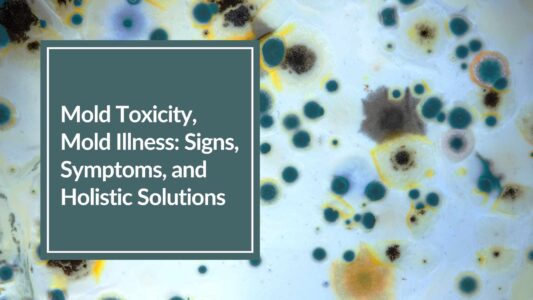
This blog contains product affiliate links. We may receive a commission if you make a purchase after clicking on one of these links. However, please note that we do not investigate, monitor, or check such external links for accuracy, adequacy, validity, reliability, availability, or completeness. We do not warrant, endorse, guarantee, or assume responsibility for the accuracy or reliability of any information offered by third-party websites linked through the site or any website or feature linked in any banner or other advertising. We will not be a party to or in any way be responsible for monitoring any transaction between you and third-party providers of products or services. By clicking on any affiliate links provided in this blog, you acknowledge and agree to these terms.
Is Your Child Showing Mold Symptoms?
Mold symptoms in kids—especially those from classroom exposure—are something every parent should keep on their radar.
Your child spends most of their day at school, where they should be safe, healthy, and learning. But what if something like mold is putting their well-being at risk? Shockingly, or maybe not even shockingly, depending on how you look at it, a study found mold in every single one of the 180 classroom air samples taken from 12 schools. That’s eye-opening, right?
Mold sickness is easy to overlook, often brushed off as minor. But the reality is black mold exposure can seriously affect a child’s health, especially with the hours they spend in the classroom.
The tricky part? Mold symptoms can look like everyday health issues, making them tough to identify. Your child might be feeling off due to something you can’t even see—the mold could be hidden, but its harmful mycotoxins are still floating around.
As a parent, it’s natural to feel concerned when your child isn’t feeling their best. Schools should be safe places, but outdated ventilation, leaky roofs, and inconsistent cleaning practices can turn classrooms into mold hotspots. The places meant to nurture our kids could be the very thing making them sick.
Mold is everywhere in our environment, but you’re not powerless. If you suspect mold in your child’s classroom—or even at home—this guide will help you spot the signs of mold symptoms and offer practical steps to tackle the problem. By taking action now, you can help protect your child’s health and make sure their learning environment is as safe as it should be.

What Is Black Mold?
Let’s clear up some confusion: the term “black mold” doesn’t refer to just one mold type. Many molds can appear black. However, when people talk about black mold, they often mean Stachybotrys chartarum, a mold notorious for its dark color and ability to produce harmful mycotoxins like trichothecenes—that can cause serious mold symptoms and even lead to mold sickness, particularly with long-term black mold exposure.
This type of mold tends to grow on water-damaged materials like wood, paper, and drywall, making it a particular concern in homes and schools.
But here’s the kicker—it’s not the only mold that looks black, nor is it necessarily the most dangerous. Other molds, like Chaetomium, Aspergillus niger, and Cladosporium, can also appear black and pose health risks, depending on the situation and individual sensitivities.
So why does Stachybotrys get such a bad reputation? Its notoriety comes from its aggressive nature and the high toxicity of the mycotoxins it releases. Public awareness campaigns and media reports have highlighted this mold, creating a perception that it’s the most dangerous one out there. But remember, any mold can be harmful under the right conditions, especially to those who are more sensitive.

Where Is Black Mold Found in School?
Schools can be prime real estate for mold growth due to their many moisture-prone areas. Here’s where you might find it:
- In roof materials above ceilings.
- Around windows.
- Near water fountains.
- On walls, ceiling tiles, and other visible surfaces.
- On hidden surfaces like the backside of drywall or wall coverings.
- Around bathroom tiles.
- In cooling coil drip pans and inside ductwork.
- In books and carpets.
When mold takes hold, it releases spores and mycotoxins into the air, which can lead to mold symptoms and mold sickness.
Mold growth can start rapidly, typically within 24-48 hours, when spores land on damp surfaces rich in organic material. Common school materials, such as drywall, wood, paper, and carpet, provide the nutrients mold needs to thrive.
Recognizing Mold Symptoms from Classroom Exposure
Mold sickness, or mold-related illness, can arise from exposure to mold spores or mycotoxins. Symptoms can overlap with common health issues, but the underlying cause may be more complex.

 One condition associated with black mold exposure is Chronic Inflammatory Response Syndrome (CIRS), a multi-system, multi-symptom illness triggered by exposure to biotoxins, including those produced by mold. CIRS can develop in individuals who are genetically predisposed and are unable to clear these toxins from their bodies effectively. This inability leads to a chronic inflammatory response, impacting multiple systems in the body and manifesting in various ways. You can read more in-depth on this in our blog: Mold Toxicity: Signs, Symptoms, Holistic Solutions.
One condition associated with black mold exposure is Chronic Inflammatory Response Syndrome (CIRS), a multi-system, multi-symptom illness triggered by exposure to biotoxins, including those produced by mold. CIRS can develop in individuals who are genetically predisposed and are unable to clear these toxins from their bodies effectively. This inability leads to a chronic inflammatory response, impacting multiple systems in the body and manifesting in various ways. You can read more in-depth on this in our blog: Mold Toxicity: Signs, Symptoms, Holistic Solutions.
Top Signs of Mold Symptoms
Here are some of the possible symptoms related to mold exposure and their impact on the body systems. From a bioenergetic perspective we look at how the body systems work together.
Disclaimer: Please note we do not diagnose or treat health conditions with bioenergetics. However, we support the body in returning to balance with bioenergetic testing, which can show organ and system stress.
Persistent Coughing and Wheezing:
When mold spores are inhaled, they can irritate the Respiratory System, leading to persistent coughing and wheezing as the body attempts to expel the irritants. The airways and lungs can become inflamed and hypersensitive due to the exposure.
Frequent Respiratory Infections:
Children who experience frequent colds, sinus infections, or bronchitis, particularly after being in school, might be dealing with mold sickness. Black mold exposure can compromise the Immune System’s ability to effectively fight off infections.
Nasal Congestion and Runny Nose:
Continuous nasal congestion or a runny nose that worsens after classroom activities can be a sign of mold exposure, as mold spores can irritate the nasal passages.
Skin Irritations and Rashes:
Mold exposure can also manifest through skin irritations or rashes affecting the Integumentary System. The skin, being the body’s largest organ, can react to mold spores and mycotoxins with symptoms such as itching, redness, and rash.
Behavioral Changes:
The impact of mold exposure is not limited to physical symptoms. Mycotoxins can cross the blood-brain barrier and are toxic to neurons which affects our overall Nervous System. Mold exposure may experience behavioral changes such as irritability, difficulty concentrating, or mood swings.
Why Are Some People Affected More Than Others?
Not everyone exposed to mold will experience mold symptoms or mold sickness. The level of sensitivity can vary greatly among individuals, often due to a combination of factors, including genetics, pre-existing health conditions, and the type of mold involved.
CIRS and Genetic Predisposition: For some, sensitivity to mold exposure goes beyond typical allergic reactions. Individuals who are genetically predisposed may develop CIRS, which can cause a wide range of symptoms that are difficult to figure out.
Allergic Reactions: For others, mold sickness may present as an allergic reaction, where the Immune System identifies mold spores as harmful and responds by releasing histamines. This can lead to symptoms like coughing, sneezing, and skin rashes. Children with existing allergies or asthma are particularly at risk, as their Immune Systems are already more reactive.
Preventing and Addressing Mold in Schools and Homes
While it’s impossible to eliminate mold entirely, especially in environments with high humidity or older infrastructure, effective prevention techniques can significantly reduce the likelihood of mold growth. Here’s how to prevent mold in classrooms and other indoor environments like your home.
1. Control Moisture Levels
- Use dehumidifiers to keep indoor humidity levels between 30-50%.
- Ensure proper ventilation, like exhaust fans.
- Repair any leaks in roofs, windows, or plumbing immediately.
- Insulate Pipes and Windows to reduce condensation.
2. Improve Airflow
- Open windows when possible to circulate fresh air.
- Use fans and maintain HVAC systems to prevent moisture buildup.
3. Educate and Raise Awareness
- See what school staff and administrators know about mold prevention and reporting any signs of mold or moisture problems.
4. Addressing Existing Mold
- Mold removal should not be taken lightly and should be handled by professionals.
Steps to Take If You Suspect Classroom Black Mold Exposure
Discuss Your Concerns: Talk to teachers or school administrators about your worries. They may not be aware of the issue and can investigate the classroom environment.
Track Symptoms: Keep track of when your child exhibits mold symptoms and their correlation with time spent in the classroom. This information can be valuable in discussions with healthcare professionals and school staff.
Consult a Healthcare Provider: If your child shows signs of mold-related health issues, seek medical advice.
Encourage School Action: Advocate for good ventilation, repair leaks, and ensure regular cleaning of classroom areas.
Ensure a Healthy Home Environment: Make sure your home is mold-free and has good ventilation. Use air purifiers and dehumidifiers to reduce moisture and improve air quality. Reduce EMF levels in your home. Our favorite is the Air Doctor!
Support Immune Health: Encourage a balanced diet rich in antioxidants, vitamins, and minerals to support your child’s Immune System. Regular exercise, adequate hydration, and sufficient sleep can help strengthen overall health and resilience against mold-related issues. Low sugar and higher fiber are helpful diet tweaks that decrease the “feeding” of mold and fungus in the body.
Focus on Detox and Drainage: Read our blog on the best toxin binders to help eliminate toxins from the body. Binders work by attaching to harmful substances like heavy metals, mycotoxins from mold, and other environmental pollutants, guiding them through the body’s natural drainage pathways.

Engage in Stress-Reducing Activities: Consider bioenergetic exercises or mindfulness practices to help mitigate the impact of mold exposure on mental well-being.
Consider a Full Scan—bioenergetic testing can help address the body as a whole and explore ways to bring it into balance.
The effects of black mold exposure can be subtle yet harmful, and addressing them early can make a significant difference.
Start by monitoring your child’s health closely and discussing any concerns with their teachers or school administrators. Advocate for a thorough inspection of the classroom environment to identify and address any mold presence. At home, create a mold-free sanctuary by maintaining proper ventilation and reducing humidity. Empower yourself with knowledge and take proactive steps to safeguard your child’s health and learning ability in a safe environment.
DISCLAIMER: These services are designed for educational purposes only and are not intended to serve as medical advice. The information provided on this site and in reports should not be used for diagnosing or treating any health problem or disease. It is not a substitute for professional care. If you have or suspect you may have a health problem or need medical attention, you should consult your healthcare provider.



